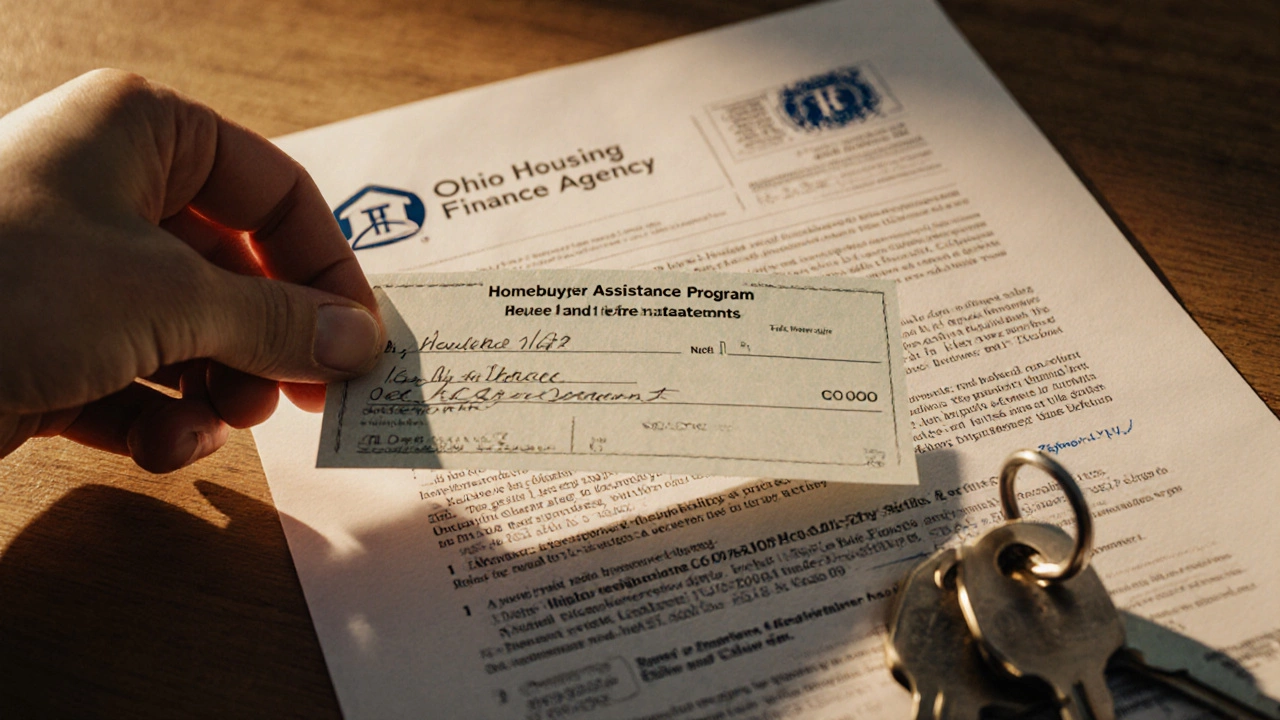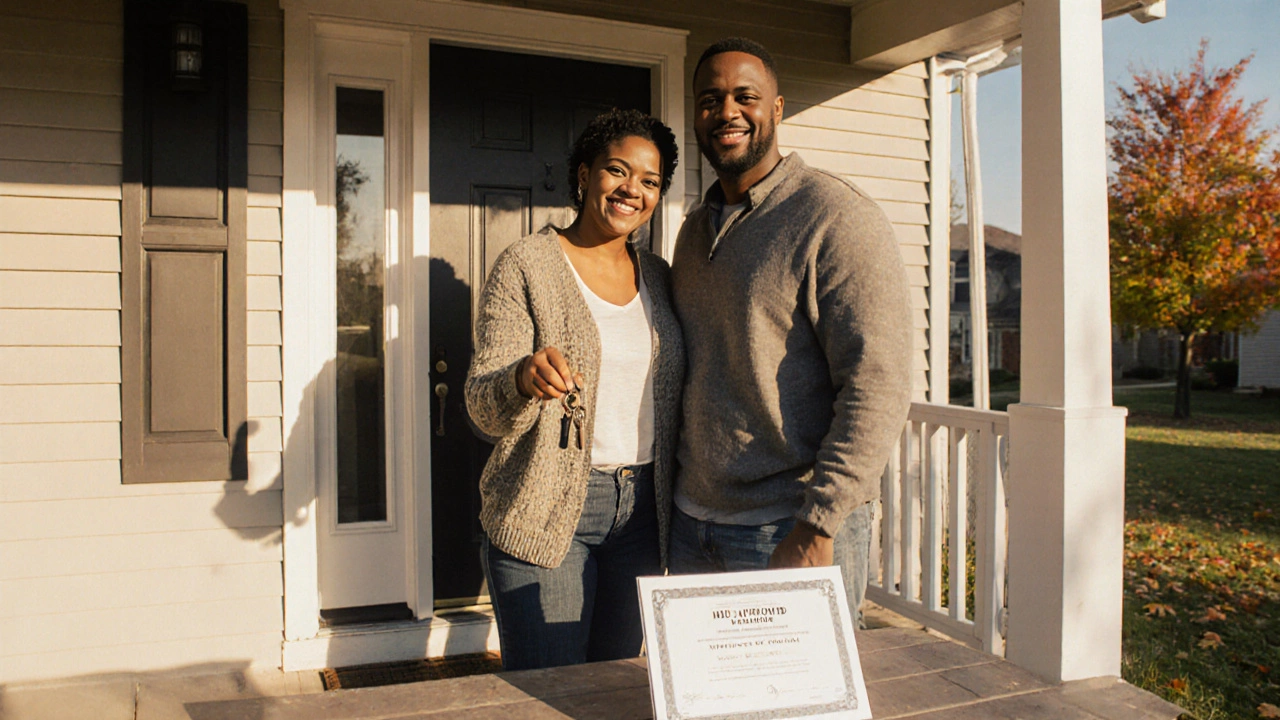Ohio First-Time Home Buyer Income Eligibility Calculator
Check if your household income qualifies for Ohio's first-time home buyer assistance programs. The calculator uses HUD's 2025 Median Family Income (MFI) data for different Ohio counties.
If you're thinking about buying your first home in Ohio, you're not alone. Thousands of people each year take that leap, and the state offers real help to make it possible. But not everyone qualifies. Knowing who can get help - and what you need to do to qualify - can save you months of guesswork and missed opportunities.
What Counts as a First-Time Home Buyer in Ohio?
In Ohio, a first-time home buyer isn’t just someone who’s never owned a home. The state also considers you a first-time buyer if you haven’t owned a home in the past three years. This rule helps people who bought and sold a home long ago - maybe during a job move or divorce - get back into the market with support.
There’s also an exception for military veterans. If you used a VA loan to buy a home before but no longer own it, you can still qualify as a first-time buyer under Ohio’s programs. Same goes for people who owned a home that wasn’t up to code or located on land that couldn’t be developed. The state looks at your situation, not just your past.
Income Limits: Can You Afford to Qualify?
Most Ohio first-time buyer programs cap your income based on where you plan to buy. The state uses Median Family Income (MFI) numbers from the U.S. Department of Housing and Urban Development (HUD). For 2025, here’s what that looks like:
- Ohio statewide average: $95,000 for a family of four
- Columbus: $102,000
- Cleveland: $89,000
- Cincinnati: $96,000
- Youngstown: $78,000
- Rural counties (like Meigs or Monroe): $72,000
If your household income exceeds the limit for your county, you won’t qualify for state-funded down payment assistance or mortgage credit certificates. But don’t assume you’re out of luck - some local city programs have higher limits or different rules.
Homebuyer Education: It’s Not Optional
Every Ohio first-time buyer program requires you to complete a HUD-approved homebuyer education course. This isn’t a formality - it’s designed to protect you. These courses cover budgeting, credit repair, mortgage types, closing costs, and what to look for in a home inspector.
You can take the course online or in person. Most take 6 to 8 hours. Some nonprofits offer them for free; others charge $50-$100. The Ohio Housing Finance Agency (OHFA) keeps a list of approved providers on their website. You’ll need a certificate to apply for any state assistance.
Down Payment and Closing Cost Help: How Much Can You Get?
Ohio’s main program for first-time buyers is the Homebuyer Assistance Program (HAP). It offers up to $10,000 in forgivable grants for down payment and closing costs. That’s not a loan - you never pay it back as long as you live in the home for five years.
There’s also the Mortgage Credit Certificate (MCC). This doesn’t give you cash upfront, but it reduces your federal income tax bill by up to 20% of your mortgage interest each year. For someone paying $12,000 in interest annually, that’s $2,400 back in your pocket. You can use this with a conventional, FHA, VA, or USDA loan.
Some counties add their own bonuses. Franklin County offers an extra $2,500 for homes in targeted neighborhoods. Toledo has a program that matches your savings dollar-for-dollar up to $5,000 if you’ve been saving for six months.

Loan Types That Work With Ohio Programs
You can use Ohio’s first-time buyer help with several types of mortgages:
- FHA loans: Require as little as 3.5% down. Most popular with first-time buyers.
- VA loans: Available to veterans and active military. No down payment needed.
- USDA loans: For homes in rural areas. Also no down payment.
- Conventional loans: You can still qualify for down payment help even if you’re putting 5-10% down.
- OHFA’s First-Time Homebuyer Loan: A 30-year fixed-rate loan with rates below market average. Only available through approved lenders.
Important: You can’t combine Ohio’s HAP grant with a 100% financing loan like VA or USDA unless you’re using the MCC. The grant is meant to cover gaps, not replace all your out-of-pocket costs.
Property Requirements: Where Can You Buy?
Your home must be in Ohio and serve as your primary residence. You can’t use the help to buy a vacation home, rental property, or investment unit.
The property must also meet basic safety standards. If you’re buying a fixer-upper, you can still qualify - but repairs must be done before closing. Some programs allow you to roll repair costs into the loan through an FHA 203(k) or OHFA’s Rehab Loan program.
There are no restrictions on home size or price, but most programs cap the purchase price at $400,000 in high-cost areas and $320,000 elsewhere. If you find a home above the limit, you can still buy it - you just won’t get state assistance on the portion over the cap.
What Disqualifies You?
Even if you think you qualify, these things will block you:
- Having owned a home in the last three years (unless you meet the military or property condition exception)
- Income over the county limit
- Not completing the required homebuyer education course
- Using the program to buy a second home or rental property
- Having a recent bankruptcy (within 2 years) or foreclosure (within 3 years)
- Using a non-approved lender
Some people think a low credit score will disqualify them - but that’s not true. Ohio’s programs accept credit scores as low as 620 for FHA loans. If your score is below that, you can still qualify if you fix your credit first and complete the education course.

How to Apply: Step-by-Step
Here’s how to get started:
- Check your income against your county’s limit on the OHFA website.
- Find a lender approved by OHFA. They’ll help you determine which loan type fits your situation.
- Enroll in and complete a HUD-approved homebuyer course. Save your certificate.
- Get pre-approved for a mortgage. This shows sellers you’re serious.
- Find a home that meets program rules. Your lender can help you confirm eligibility.
- Submit your application through your lender. They’ll handle the paperwork with OHFA.
- Close on your home. The assistance funds will be applied at closing.
The whole process usually takes 60 to 90 days from start to finish. Don’t wait until you’ve found a home to start - you need to get pre-approved before you make an offer.
What Happens After You Buy?
If you get a forgivable grant like the HAP, you must live in the home for five years. If you sell or move out before then, you may have to repay part of the grant. The repayment amount decreases each year - 20% per year, so if you leave after three years, you pay back 40%.
If you get the Mortgage Credit Certificate, you’ll need to file IRS Form 8396 every year to claim the tax credit. Keep your closing documents and loan statements. You can claim it for as long as you own the home and have mortgage interest.
Many buyers don’t realize they can still get help after closing. Ohio offers free housing counseling for the first year. If you’re struggling with payments or repairs, you can call OHFA’s hotline - they’ll connect you with a counselor at no cost.
Can I use Ohio first-time buyer programs if I’m not a U.S. citizen?
Yes, as long as you’re a lawful permanent resident with a valid Social Security number and can prove legal residency. You don’t need to be a U.S. citizen. Some programs may require additional documentation, like a copy of your green card or work visa, but citizenship isn’t a barrier.
Can I buy a condo or townhouse with Ohio first-time buyer help?
Absolutely. Condos, townhouses, and single-family homes all qualify as long as they’re your primary residence and meet the program’s property standards. Many first-time buyers in Columbus and Cincinnati choose condos because they’re more affordable and easier to maintain.
Do I have to buy a new home, or can I use the program for a resale home?
You can buy a resale home - in fact, most first-time buyers do. The program doesn’t care if the home is new construction or 50 years old. What matters is that it’s safe, habitable, and meets local building codes. You can even buy a home that needs repairs, as long as you use an approved rehab loan.
What if my spouse owned a home before we got married?
If your spouse owned a home in the last three years, you both lose eligibility - even if you’re buying alone. Ohio looks at the household, not just the individual. The only exception is if you’re legally separated or divorced and your spouse’s home was not your primary residence.
Is there a limit on how many times I can use these programs?
You can only use Ohio’s first-time buyer programs once. Once you’ve closed on a home using a grant or MCC, you’re no longer eligible - even if you sell that home later. That’s why it’s important to use the help wisely and plan for long-term ownership.
Next Steps: What to Do Right Now
Don’t wait for the perfect moment. Right now, Ohio has funding available through 2025. Start by visiting the Ohio Housing Finance Agency website and downloading their First-Time Homebuyer Checklist. Then, call one of their approved lenders - they’ll walk you through your options at no cost.
If you’re unsure about your income limit, use the HUD income calculator. It’s free, takes five minutes, and tells you exactly where you stand. And if you’re worried about your credit, get a free report from AnnualCreditReport.com - fix any errors before you apply.
First-time home buying in Ohio isn’t magic. It’s a system designed for people like you - with clear rules, real help, and a path forward. You just need to take the first step.
